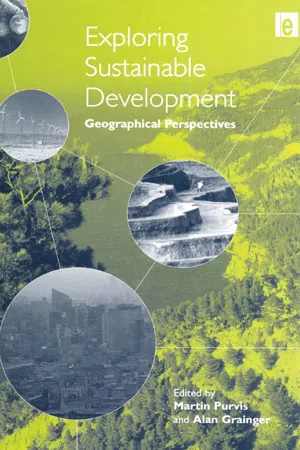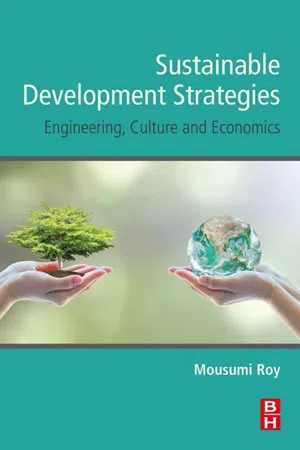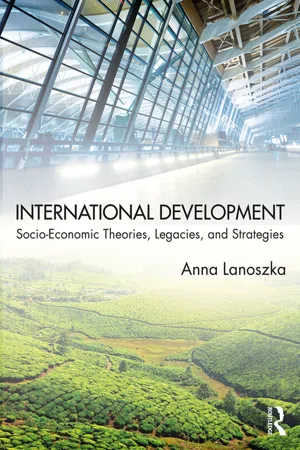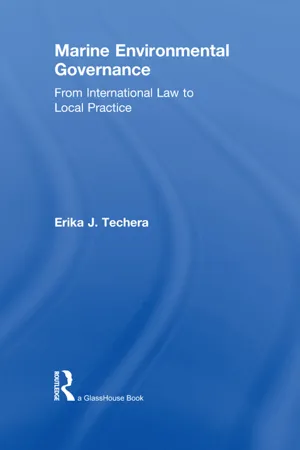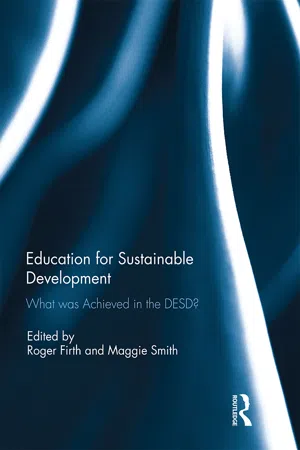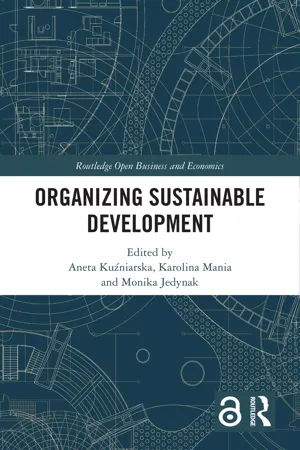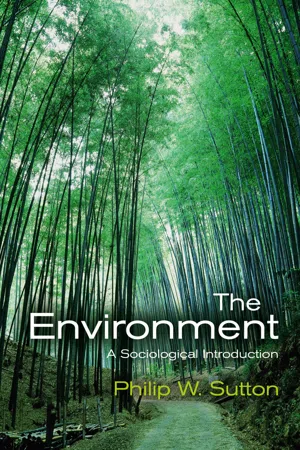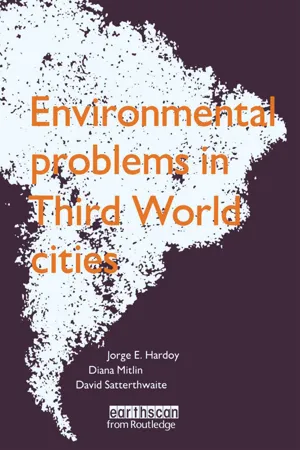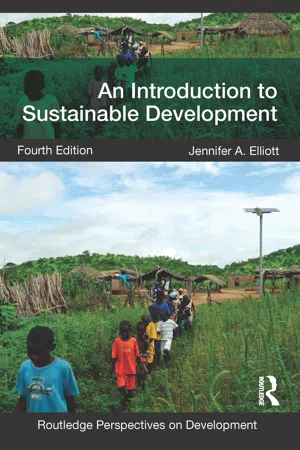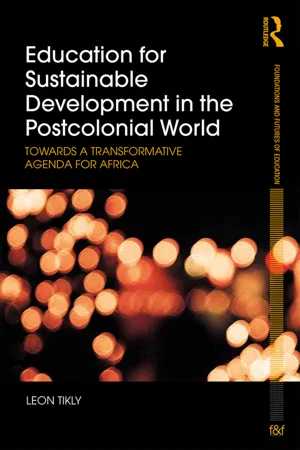Geography
Sustainable Development
Sustainable development refers to the practice of meeting the needs of the present without compromising the ability of future generations to meet their own needs. It involves finding a balance between economic growth, social progress, and environmental protection. Sustainable development aims to create a stable and equitable society that can thrive without depleting natural resources or causing harm to the environment.
Written by Perlego with AI-assistance
Related key terms
10 Key excerpts on "Sustainable Development"
- eBook - ePub
Exploring Sustainable Development
Geographical Perspectives
- Martin Purvis, Alan Grainger(Authors)
- 2013(Publication Date)
- Routledge(Publisher)
2
Geography and SustainableDevelopment
Martin Purvis
Introduction
The current state of the world has led many commentators to conclude that the unequal priority given to economic growth, social welfare and the health of the environment renders established development patterns unsustainable. The alternative ideal of Sustainable Development – that which ‘meets the needs of the present without compromising the ability of future generations to meet their own needs’ (WCED, 1987) – has, therefore attracted increasing support. But once we look beyond such broad definitions, much remains elusive and contested about Sustainable Development. As noted in Chapter 1 , the scope of existing economic theory is limited, and few others have taken up the challenge of establishing a sound theoretical foundation for future action. It is, of course, also true that the label of Sustainable Development is applied to an increasing number of practical measures. However, the sheer number and diversity of such initiatives, and the mixture of motives that inspire them, only adds to the ambiguity which surrounds the concept. There is still, therefore, much work to be done if Sustainable Development is to be established as a credible blueprint for the 21st century.The chapter begins by comparing geography’s long-standing interest in both society and nature, and the links that unite them, with the new agenda of Sustainable Development. This is followed by a brief review of the attention given to Sustainable Development in the geographical literature, and to the themes of place and space in discussions of Sustainable Development. The chapter then moves on to consider the potential for applying geographical skills in planning for more Sustainable Development. Arguably more important, however, is a greater geographical contribution to critical reviews of current thinking about Sustainable Development, both in practice and in theory. - eBook - ePub
Sustainable Development Strategies
Engineering, Culture and Economics
- Mousumi Roy(Author)
- 2020(Publication Date)
- Butterworth-Heinemann(Publisher)
Failure of the economic growth model based on only efficiency and unlimited growth has resulted in continuous degradation of social and ecological conditions denying even the basic conditions of living to vast section of population in most societies. Since the Stockholm Conference on Human Environment in 1972, the great awakening and coming together of the international community on the most important environmental issues, such degradation as reflected in several related phenomena has been more prominently observed. Intense global environmental problems as increasingly evident in global warming, climate change, biodiversity loss, depletion of natural resources, environmental degradation of soil, air and water bodies and alteration of the nitrogen cycle coupled with poverty trap, social vulnerability, poor working conditions, unemployment, widening inequalities, and financial volatility, resulting from extensive anthropogenic activities and fueled by rapid economic growth beyond the “widest Neolithic dreams,” have now challenged our understanding of the existing economic process as purely positive. This has raised questions about whether the present progress can be sustained in the future. Sustainable Development has now emerged as a development paradigm to maintain a balanced integration of socioeconomic needs with the regenerative capacity of the planet Earth when the life support system of our planet is threatened.1.2 Defining Sustainable Development
With diverse human societies, ecosystems, and complex challenges arising from heterogeneous socioeconomic consequences, new definitions of Sustainable Development are continually formulated, accommodating a variety of understandings and expectations for desirable progress. The World Commission on Environment and Development (WCED) defined Sustainable Development as “meeting the needs of the present generation without compromising the ability of the future generations to meet their own needs.” This was published in the Brundtland report “Our Common Future” [1] . In this most prominent understanding of Sustainable Development, the concept of Sustainable Development does imply “limits-not absolute limits but limitations imposed by the present state of technology, social organization on environmental resources and by the ability of the biosphere to absorb the effects of human activities” [1] - eBook - ePub
International Development
Socio-Economic Theories, Legacies, and Strategies
- Anna Lanoszka(Author)
- 2018(Publication Date)
- Routledge(Publisher)
7I Conceptualizing Sustainable Development
For the most part of the world’s history, humans have pursued technological advancements and used the available land with little attention paid to the conservation of natural environments. Scarcity is one of the defining aspects of economic analysis, but this term was not born out of concern for nature. The dilemma of scarcity is about limited resources for a society with unlimited wants. Classical theories of economics were never preoccupied with the issue of Earth’s limited natural resources. Only over the last few decades, have policy makers started to acknowledge environmental harms caused by rapid industrialization, resource extraction, and overuse of land. The prerogative to consume natural resources wisely has become more pronounced as the global population continues to grow.There are inescapable linkages among economic activities, state policies, natural resources, the ecosystem, and how societies function. The concept Sustainable Development was coined in recognition of how connected the issues at stake are. Formal debates about the environment first emerged at the 1972 United Nations Conference on the Human Environment in Stockholm, Sweden. The central themes of the conference were:• the interdependence of human beings and the natural environment;• the links between socio-economic development and environmental protection;• the need for a global vision and common approach to environmental problems.Building upon these themes, the World Commission on Environment and Development released a report in 1987 defining Sustainable Development as: “development that meets the needs of the present without compromising the ability of future generations to meet their own needs.”1It took another five years until a comprehensive set of multilateral documents dealing with the issue of Sustainable Development were adopted by more than 178 governments. The acceptance took place at the 1992 UN Conference on Environment and Development, held in Rio de Janeiro, Brazil. At the same time, the UN created a special Commission on Sustainable Development, tasked with monitoring and reporting on the implementation of the landmark Rio agreement. In 2013, this commission was replaced by the UN high-level political forum (HLPF) on Sustainable Development, which is currently responsible for adopting negotiated declarations and for helping to define the developmental agenda of the UN. - eBook - ePub
Marine Environmental Governance
From International Law to Local Practice
- Erika Techera(Author)
- 2013(Publication Date)
- Routledge(Publisher)
170 the signatories. Their greatest power lies in the international standard-setting role they have played in the development of global and national laws that integrate these multiple concerns as well as providing guidelines for affirmative action.What is Sustainable Development?
The phrase ‘Sustainable Development’ has come to dominate environmental governance discourse but its precise meaning remains unclear. Arguably, in 1992 the definition of Sustainable Development was ‘simple and vague’171 in order to attract broad international acceptance, but in the decades that have followed criticism has been levelled at the lack of an explanation as the achievement of Sustainable Development remains elusive.172 The absence of a universal definition has resulted in a complexity of issues for policy-makers and those charged with its implementation. It has arguably contributed to the failure to meet set targets and goals173 and rendered the concept open to abuse.174 Conversely, determining a fixed meaning may be of only limited value if it results in a loss of flexibility, and perhaps on this basis it was intentionally left unclear.175 Thus the meaning of Sustainable Development has been able to change and expand in answer to evolving challenges.176 This can be seen through the shifting focus of the international instruments that support it, in particular the Rio Declaration , Agenda 21 and the Johannesburg Declaration and JPOI.Nevertheless attempts have been made to define it. The definition popularised by the Brundtland Report is development ‘which meets the needs of today without compromising the ability of future generations to meet their needs’.177 This generalist explanation incorporates two elements: first, human needs, and second, restraints. The former would presumably include basic needs such as food, water and shelter, and therefore incorporates the necessity to eradicate poverty through development and equitably share natural resources. The latter refers to limitations which are inherent in the environment in terms of non-renewable resources and ecosystem services, but also in humans in terms of our own abilities. It is possible in this way to rely upon the Brundtland - eBook - ePub
Education for Sustainable Development
What was achieved in the DESD?
- Roger Firth, Maggie Smith(Authors)
- 2018(Publication Date)
- Routledge(Publisher)
Perhaps in response to this issue there have been attempts to describe the term Sustainable Development using a variety of categories (Kilinc & Aydin, 2011). For example, Dawe, Jucker, and Martin (2005) use nine categories pertaining to Sustainable Development: diversity, needs and rights of future generations, uncertainty and precautions, social justice, interdependence, citizenship and stewardship, acceptance of limits, deceleration and the idea that small is beautiful. Perhaps interestingly, the UK Sustainable Development Education Panel (SDEP) itself revised the definition of Sustainable Development within the English National Curriculum in 2000 to include seven key concepts: interdependence (of society, economy and the natural environment, from local to global); citizenship and stewardship; needs and rights of future generations; diversity (cultural, social, economic and biological); quality of life, equity and justice, sustainable change; and uncertainty, and precaution in action (DfEE/QCA, 1999). The SDEP argued that in breaking down Sustainable Development into a set of key concepts, it would help the complex underlying theory of ESD to be understood by teachers and students, thereby rejecting the attempt to reduce Sustainable Development to one basic definition. In theory this rationale is useful in that it recognises the complexities of Sustainable Development and the need for students to be taught about the difficulties of achieving it. However, the extent to which this has been used within schools either through curriculum development or by individual teachers in school is unclear.More common definitions of Sustainable Development argue that there are three ‘dimensions’ of sustainability, environmental, economic and social, and that these three areas are interrelated such that any definition of Sustainable Development needs to centre on the interrelationships between these three dimensions (e.g. Peterson & Alkis, 2009). However, the relationship between these three areas can be represented in various ways, each one portraying a different view of the essence of sustainability (Figure 1 - eBook - ePub
- Aneta Kuźniarska, Karolina Mania, Monika Jedynak(Authors)
- 2023(Publication Date)
- Routledge(Publisher)
These concepts also bring together discourses from different fields, as illustrated by the broad view taken in the SDGs (Ramos et al., 2020 ; UN General Assembly, 2015). Although definitions of Sustainable Development vary, often causing conceptual confusion that makes it difficult to put the concept into practice (Sheehy & Farneti, 2021), the SDGs are widely recognised as a normative compass for Sustainable Development policy-making (Fukuda-Parr, 2016 ; Koff et al., 2022). The Sustainable Development strategy is interdisciplinary and refers to all dimensions of sustainability. To implement it, it is necessary to convince people of the value of the idea of sustainability (Pawłowski, 2008). Changes in people’s attitudes are referred to as the internal dimension of sustainability or change from within (Horlings, 2015). A matter of great importance is environmental education, which must integrate into topics other than just nature. Adopting this more complex perspective should encourage and enable management educators to take into account conflicting yet interrelated issues and open the door to more creative teaching, research and theory-building, as well as ethical dilemmas in decision-making (Moratis & Melissen, 2022). With the climate crisis worsening, following a pandemic that is delaying the realisation of the SDGs (The Sustainable Development Goals Report 2021, 2021), during the Russian aggression in Ukraine, it is difficult to predict the actual long-term effects of human activity. Global problems have reached a scale and level of complexity that makes it difficult, if not impossible and to solve them within the assumed timeframe. Hence the need to take a broader view of sustainability and consider its many dimensions. References Allen, A. (2009). Sustainable cities or sustainable urbanisation? Palette UCL’s Journal of Sustainable Cities, 1. Ávila, C., Cedano, K., & Martínez, M. (2017) - eBook - ePub
The Environment
A Sociological Introduction
- Philip W. Sutton(Author)
- 2013(Publication Date)
- Polity(Publisher)
chapter 9 , in an age of globalization, Sustainable Development does represent a concerted attempt to find ways of combining the diverse interests of the relatively rich and relatively poor countries of the world in order to reduce the human ‘footprint’ on the natural environment. However difficult this may be, it does partly explain why Sustainable Development has attracted such a wide and receptive audience.The Idea of Sustainable DevelopmentWhile governments around the world have become involved in the conservation of natural resources at various times in modern history, most of this involvement has been for specific uses, such as forestry management to establish reserves of timber to be used in construction. Once the environmental movement became a mass social movement of many millions of people, it was no longer possible to see environmental protection as an optional addition to mainstream politics. Instead, environmental issues were being rapidly mainstreamed in society alongside problems of poverty in a global context, which particularly affects the fate of people in developing countries. Set-piece global music events that raise money for famine relief and aid or push for the writing-off of debt in developing countries have attracted huge television audiences across the world. Events such as Live Aid in 1985 and Live 8 in 2005 are just the visible tip of a growing concern with global inequalities and environmental problems. Also, because many of the environmental issues of recent times have a strongly international or global dimension, particularly in their consequences and impacts, international political cooperation has come to be seen as vital if they are to be effectively tackled. It has also become clearer that global environmental problems will not be readily solved in the short or medium term. They are very long-term problems of population growth and of human adaptation to the natural environment. - eBook - ePub
- Jorge E. Hardoy(Author)
- 2024(Publication Date)
- Routledge(Publisher)
In the South, widespread poverty exists and four decades of ‘development planning’ have failed to substantially lessen the proportion of the population living with their basic needs unmet – and there are worrying trends in terms of unsustainable levels of use for some resources too (for instance through deforestation and soil erosion). In the North, the problem centres on the scale of resource use, waste, pollution and greenhouse gas emission – although even in richer countries, there are also millions of people whose development needs are not met. While meeting the needs of poorer groups in both the North and the South need not imply an unsustainable level of resource use, it is clear that extending the levels of resource consumption and waste generation currently enjoyed by the rich minority to an increasing proportion of the world’s population almost certainly does. 2 Sustainable Development The term ‘Sustainable Development’ brings together two strands of thought about the management of human activities – one concentrating on development goals, the other on controlling or limiting the harmful impacts of human activities on the environment. Although the origins of a concern for both the environment and development go back several decades, this concern was made more explicit, and the use of the term ‘Sustainable Development’ promoted, by Our Common Future, the Report of the World Commission on Environment and Development (also known as the Brundtland Commission), published in 1987. In one of the most widely quoted definitions of the goal of Sustainable Development, the report states that we must meet ‘the needs of the present generation without compromising the ability of future generations to meet their own needs’. 3 In the broadest sense, most discussions about Sustainable Development fall within this definition, although different groups chose to emphasise different aspects - eBook - ePub
- Jennifer Elliott(Author)
- 2012(Publication Date)
- Routledge(Publisher)
These same pleas are currently being voiced as the global community attempts to respond to the unfolding economic crisis. Coordinated political action and responsibility is currently being negotiated by finance ministers within the Euro zone to determine the economic future of whole countries such as Greece, and avoiding a return to protectionism is considered key to the economic future of the European Union as a region. The ‘Occupy movement’, a coalition of campaigners whose actions have created attention in many cities across the world, has highlighted the extremes and injustices of global capitalism and the new norms of behaviour that are required particularly within the global banking and finance industries but also within governments to ensure these institutions operate in the interests of all. Evidently, the challenges of reconciling different interests and ensuring inclusivity even as common futures are acknowledged continues to prove a difficult and ever more urgent challenge. However, it is also suggested that:We are now at an exciting stage in the awkward but vital, transition to sustainability. In international government, in national strategies, in business, in community action and in individual behaviour and outlook, we are beginning to witness a dawning realisation that global humanity has to shift if future generations are to survive with any meaningful sense of prosperity and well-being.(O’Riordan, 2009: 307)Whilst the emphasis within this text was has been on the particular environment and development challenges and progress in the developing world, the interdependence of different regions of the world has been demonstrated repeatedly: where change in any one element of the world’s atmospheric system has implications for the functioning of the system as a whole (and all organisms living within it); where a substantially globalised economic system operates through geographical differences (of both the physical and human environments); and where individual human rights are now understood to connect to global security and to the global challenge of Sustainable Development.Throughout the text, the detail of the patterns and processes of development (and the outcomes of policies and projects towards Sustainable Development) has shown substantial evidence of the global nature of the challenges of Sustainable Development. Climate warming presents the archetypal global environmental problem and challenges the social sciences as well as the earth sciences, international relations and all countries to find lower-carbon processes and patterns of production and consumption. Worldwide there are also local problems of natural resources decline, pollution and degradation of the varied services that ecosystems provide and that are essential to human well-being, as revealed within the Millennium Ecosystem Assessment. The expansion of Multilateral Environmental Agreements, the outcomes of core summits on environment and development and the international commitments to the Millennium Development Goals have been provided as evidence that the common nature of the global challenge of Sustainable Development has been recognised at the highest political level. - eBook - ePub
Education for Sustainable Development in the Postcolonial World
Towards a Transformative Agenda for Africa
- Leon Tikly(Author)
- 2019(Publication Date)
- Routledge(Publisher)
3 Towards a framework for conceptualising education for Sustainable DevelopmentIntroduction
The aim of this chapter is to begin to set out an alternative vision of ESD that can guide discussion in the remainder of the book. The chapter will start by considering how Sustainable Development (SD) can be understood in broad terms. Attention will then turn to developing an ethical basis for considering the role of education in relation to Sustainable Development. In particular, an attempt will be made to set out a view of social and environmental justice drawing on Sen’s ideas of capability and Nancy Fraser’s ideas about global justice but relating these to more recent scholarship on the meaning of environmental justice. It will be suggested that considering the role of education and training in relation to the development of valued capabilities for achieving sustainable livelihoods and the barriers and affordances available to different groups in society to develop valued capabilities and functionings provides a useful starting point for reconceptualising ESD.The meaning of ‘Sustainable Development’ in global and regional policy agendas
Space does not allow for a full account of the development of SD as a discourse which has in any case been provided elsewhere (e.g. Elliot 2013). A summary of key milestones in the development of SD as a global policy discourse from the influential Stockholm Conference in 1972 and leading up to the adoption of the SDGs is provided in Box 3.1 .Box 3.1 Key milestones in the development of SD as a global policy discourse- 1 The United Nations Conference on the Human Environment, held in Stockholm on 5–16 June 1972, first gave visibility to the idea of a need for a ‘synthesis between development and environment’ (UN 1972, 45).
- 2 The report of the Club of Rome, an international think tank comprised of leading industrialists, academics, and policy makers, entitled the Limits of Growth
Index pages curate the most relevant extracts from our library of academic textbooks. They’ve been created using an in-house natural language model (NLM), each adding context and meaning to key research topics.
